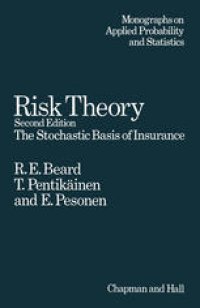
Ebook: Risk Theory: The Stochastic Basis of Insurance
Author: Robert Eric Beard O.B.E. F.I.A. F.I.M.A. Teivo Pentikäinen Phil. Dr. Erkki Pesonen Phil. Dr. (auth.)
- Tags: Science general
- Series: Monographs on Applied Probability and Statistics 1
- Year: 1977
- Publisher: Springer Netherlands
- Edition: 1
- Language: English
- pdf
whioh the developments are appropriate in an elementary text book is open to doubt. Fortunately the proceedings of the conference arranged by the Society of Actuaries Research Committee in September 1974 provide an effective review of the ourrent position (Credibility, Theory and Applications, Ed. P. M. Kahn, Academic Press, 1975). It is doubtful if any practical use is now made of the Esscher approximation and the N-P method is much more convenient and of adequate accuracy in most practical work. Thus the first half of Chapter 6 is now largely of historical interest. Chapter 11 dealing with ruin probability during a finite time interval does not give an adequate view of the current importanoe of this topic but the position is fluid because of the considerable effort being expended in the search for practical methods of calcu lation. Formulae are, in general, complicated and involve extensive computer based quadratures or simulation techniques. The paper by Seal in the Scandinavian Actuarial Journal (The Numerical Calculation of U(w,t) the Probability of Non-ruin in an Interval (O,t) 1974) gives a recent treatment and a fairly complete list of relevant references. In many countries studies are currently in progress in the develop ment of models for business planning where the basic operations involve a stochastic process. Not only are insurance companies interested but in many commercial and industrial firms the needs are significant so that a very large field exists for applications.
1. Definitions and Notations.- 1.1 The Purpose of the Theory of Risk.- 1.2 Random Processes in General.- 1.3. Positive and Negative Risk Sums.- 1.4. Main Problems.- 2. Process with Constant Size of One Claim.- 2.1. Introduction.- 2.2. The Poisson Process.- 2.3. Discussion of Assumptions.- 2.4. Numerical Calculations.- 2.5. Application 1.- 2.6. Application 2.- 3. Generalized Poisson Distribution.- 3.1. The Distribution Function of the Size of a Claim.- 3.2. Generalized Poisson Function.- 3.3. The Mean and Standard Deviation of F(x).- 3.4. Characteristic Function.- 3.5. Estimation of S(z).- 3.5.1. Individual Method.- 3.5.2. Statistical Method.- 3.5.3. Problems Arising from Large Claims.- 3.5.4. The Dependence of the S-Function on Reinsurance.- 3.5.5. Analytical Methods.- 3.5.6. Exponential Function.- 3.5.7. A Generalization of the Exponential Type.- 3.5.8. Other Types of Distribution.- 3.6. Decomposition of S(z).- 4. Normal Approximation and Edgeworth Series for F(x).- 4.1. The Normal Approximation.- 4.2. Edgeworth Series.- 4.3. Normal Power Expansion.- 4.4. The Accuracy of the Normal Approximation.- 5. Applications of the Normal Approximation.- 5.1. The Basic Equation.- 5.2. Net Retention.- 5.3. Reserve Funds.- 5.4. Statutory Basis of Reserve Funds.- 5.5. The Rule of Greatest Retention.- 5.6. The Case of Several M’s.- 5.7. An Application to Insurance Statistics.- 5.8. Experience Rating, Credibility Theory.- 6. The Esscher Approximation.- 6.1. Introduction.- 6.2. The Accuracy of the Esscher Formula.- 6.3. Some Hints for Numerical Computations.- 6.4. Examples of Numerical Applications.- 7. Monte Carlo Method.- 7.1. Random Numbers.- 7.2. Simulation of Generalized Poisson Function.- 7.3. Discussion on the Accuracy and a Modification.- 8. Other Methods of Calculating the Generalized Poisson Function.- 8.1. Inversion of the Characteristic Function.- 8.2. A Modification of the Esscher Method.- 8.3. Step Function Approximation of S(z).- 8.4. Exponent Polynomials.- 8.5. Mixed Methods.- 8.6. Statistical Method.- 9. Variance as a Measure of Stability.- 9.1. Optimum Form of Reinsurance.- 9.2. Reciprocity of Two Companies.- 10. Varying Basic Probabilities.- 10.1. Introduction.- 10.2. Compound Poisson Process.- 10.3. Direct Numerical Computation of the Compound Poisson Function.- 10.4. The Polya Process.- 10.5. Application to Stop Loss Reinsurance.- 11. The Ruin Probability During a Finite Time Period.- 11.1. The Ruin Function in Finite Time Periods.- 11.2. Calculation of ?N(U) by a Monte Carlo Method.- 12. The Ruin Probability During an Infinite Time Period.- 12.1. Introduction.- 12.2. Ruin Probability.- 12.3. Applications.- 12.4. Some Approximation Formulae.- 12.5. Discussion on the Different Methods.- 13. Application of Risk Theory to Business Planning.- Appendix A. Derivation of the Poisson Process and Compound Poisson Processes.- Appendix B. The Edgeworth Expansion.- Solutions to the Exercises.- Author Index.